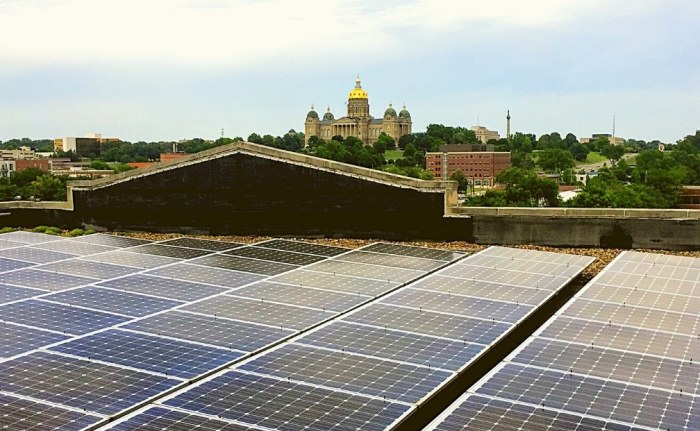Raihan Rashidi, a clean energy field organizer for the Iowa Environmental Council, wrote this post, which first appeared on that organization’s blog. -promoted by Laura Belin
Reading incessant news about climate-related disasters across the country and here in Iowa has made me wonder if we are just going to sit idly and hope the world miraculously recovers while we maintain our current ways. Or if we are going to accept the science and quickly act to prevent prolonged power outages or severe crop damages the next time a storm or drought hits us. Despite the many challenges 2020 has thrown upon us, I am hopeful it will be the latter.
This is where the 100% DSM movement comes into play.
This exciting local initiative has been gaining traction over the last several months, with a goal to reach 24/7 emissions-free electricity for all Des Moines residents and buildings by 2030. The Des Moines City Council has recently introduced and filed a draft resolution to do just that and it is crucial that the city commits to this goal by the end of the year.
Commitments like this are not new – with over 160 cities nation-wide having made similar pledges to achieve 100 percent renewable energy. These include neighboring Midwestern cities like Minneapolis and St. Louis. Their goals are to reach 100 percent clean energy for municipal facilities and operations by 2022 and 2025 and community-wide by 2030 and 2035, respectively. Des Moines should be next and ultimately, champion Iowa’s climate and clean energy leadership.
Although Des Moines’ utility provider, MidAmerican Energy, claims to be on the path to delivering 100 percent clean power to its customers, the company still operates or co-operates five coal plants statewide. Consequently, more than a third of the electricity they generated in 2019 came from coal. Running these fossil fuel facilities has proven to be uneconomic, while also negatively impacting the climate and public health. Despite the 100 percent claim, we have heard no commitment from the company to retire these costly and harmful facilities, making MidAmerican’s parent company a national outlier.
Yet Iowa’s other energy supplier, Alliant Energy, has just announced the upcoming retirement of its Lansing coal plant and the conversion of its Burlington facility to fossil gas. The power will be replaced by utility-scale solar and smaller-scale solar paired with battery storage. This is a step in the right direction for Iowa to modernize its electricity generation with clean sources, and MidAmerican should follow suit.
The just clean energy transition offers a wide variety of benefits outside of lower utility costs and reduced emissions. Residents can also realize cleaner air and water, greater public health, community resilience, environmental equity, and economic growth. The city can be a sustainable place for businesses to operate, while increasing local green jobs that are typically the fastest growing professions in the nation.
We want all homes and businesses to increase their resiliency in the event of an outage by utilizing the efficient use of battery storage and microgrids sourced by wind and solar. Most importantly, this shift will protect vulnerable communities from high-energy costs, polluted neighborhoods, and adverse health effects.
It is past time for us to take on this goal that requires a decade of bold and consistent action. The 100% DSM campaign has garnered support from a broad coalition of local organizations, business leaders, and individuals who want to see a better Des Moines for their families and future generations.
I am continually inspired by the power of activism that continues to mobilize different voices in our community, to develop climate solutions, and help influence our decision-makers in doing what is best for all residents. For Des Moines readers, head to 100% DSM: Take Action to urge your city councilmembers to support the resolution.
Top photo provided by the Iowa Environmental Council and published with permission.

